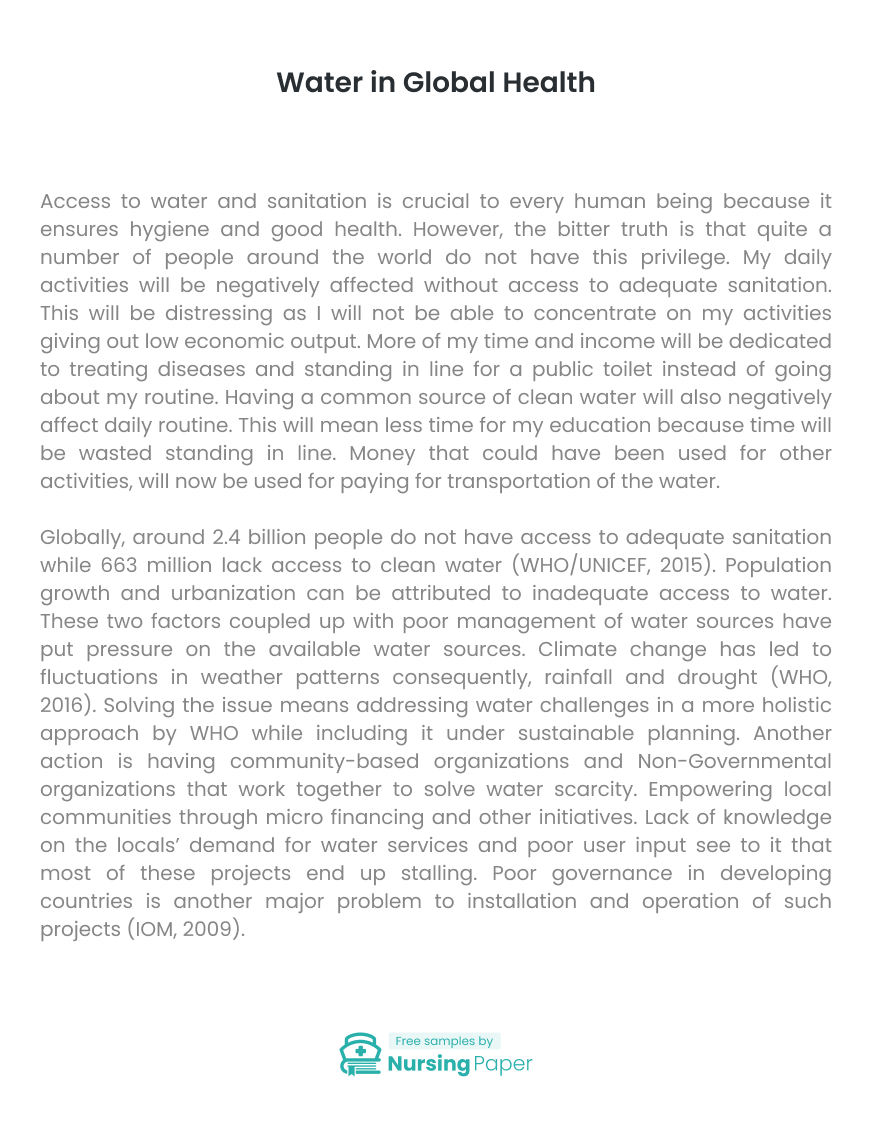
Water in Global Health
Introduction
Access to water and sanitation is crucial to every human being because it ensures hygiene and good health. However, the bitter truth is that quite a number of people around the world do not have this privilege. My daily activities will be negatively affected without access to adequate sanitation. This will be distressing as I will not be able to concentrate on my activities giving out low economic output. More of my time and income will be dedicated to treating diseases and standing in line for a public toilet instead of going about my routine. Having a common source of clean water will also negatively affect daily routine. This will mean less time for my education because time will be wasted standing in line. Money that could have been used for other activities, will now be used for paying for transportation of the water.
Globally, around 2.4 billion people do not have access to adequate sanitation while 663 million lack access to clean water (WHO/UNICEF, 2015). Population growth and urbanization can be attributed to inadequate access to water. These two factors coupled up with poor management of water sources have put pressure on the available water sources. Climate change has led to fluctuations in weather patterns consequently, rainfall and drought (WHO, 2016). Solving the issue means addressing water challenges in a more holistic approach by WHO while including it under sustainable planning. Another action is having community-based organizations and Non-Governmental organizations that work together to solve water scarcity. Empowering local communities through micro financing and other initiatives. Lack of knowledge on the locals’ demand for water services and poor user input see to it that most of these projects end up stalling. Poor governance in developing countries is another major problem to installation and operation of such projects (IOM, 2009).


1. Institute of Medicine (US) Roundtable on Environmental Health Sciences, Research, and Medicine. (2009). Global Environmental Health: Research Gaps and Barriers for Providing Sustainable Water, Sanitation, and Hygiene Services. Washington DC: National Academies Press.
2. WHO/UNICEF. Joint Monitoring Programme (JMP) Report. (2015). Progress on Sanitation and Drinking Water: 2015 Update and MDG Assessment. Geneva. Press Release.
3. World Health Organization. (2016). Drinking Water Fact Sheet. Retrieved from www.who.int/mediacentre/factsheets/fs391/en/



The download will start shortly.

The download will start shortly.
 Subject:
Medicine
Subject:
Medicine  Number of pages: 1
Number of pages: 1  Subject:
Health and Social Care
Subject:
Health and Social Care  Number of pages: 3
Number of pages: 3  Subject:
Nursing
Subject:
Nursing  Number of pages: 2
Number of pages: 2  Subject:
Medicine
Subject:
Medicine  Number of pages: 3
Number of pages: 3  Subject:
Nursing
Subject:
Nursing  Number of pages: 5
Number of pages: 5  Subject:
Nursing
Subject:
Nursing  Number of pages: 9
Number of pages: 9  Subject:
Nursing
Subject:
Nursing  Number of pages: 5
Number of pages: 5  Subject:
Health and Social Care
Subject:
Health and Social Care  Number of pages: 4
Number of pages: 4  Subject:
Health and Social Care
Subject:
Health and Social Care  Number of pages: 3
Number of pages: 3  Subject:
Health and Social Care
Subject:
Health and Social Care  Number of pages: 6
Number of pages: 6  Subject:
Health and Social Care
Subject:
Health and Social Care  Number of pages: 3
Number of pages: 3  Subject:
Health and Social Care
Subject:
Health and Social Care  Number of pages: 2
Number of pages: 2  Subject:
Health and Social Care
Subject:
Health and Social Care  Number of pages: 3
Number of pages: 3  Subject:
Health and Social Care
Subject:
Health and Social Care  Number of pages: 3
Number of pages: 3  Subject:
Nursing
Subject:
Nursing  Number of pages: 2
Number of pages: 2 
